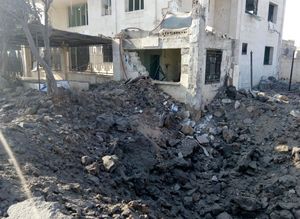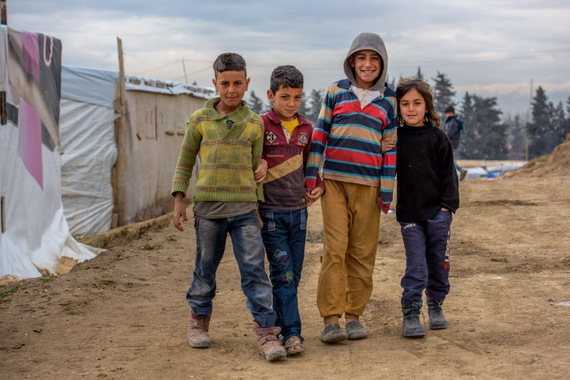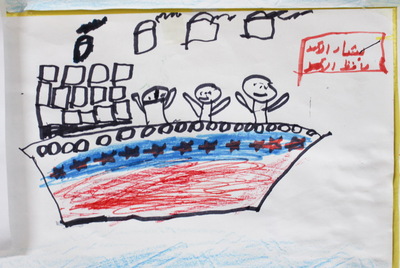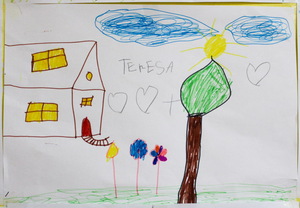Stephanie Hammond, Policy Advisor, Conflicts and Disasters, World Vision
The Syrian conflict and the resulting refugee crisis in the region and across Europe has dominated media headlines for months. And the numbers of those affected are likely to continue to grow. Within the past month, tens of thousands of vulnerable civilians have been displaced from their homes in northern Syria, many for the second or third time. Just last week World Vision released photos of a newborn 
babies and children's hospital impacted by bombing - one of the many examples of the most innocent getting caught up in the brutality of this conflict.
The conflict has left an estimated 13.5 million people, including over 6 million children, in need of humanitarian assistance and protection inside Syria alone. For those who have managed to flee the conflict, half of the refugee population comprises children, meaning that over 2 million Syrian children are growing up as refugees. This has left at least 8.2 million children inside Syria and across the region who now experience displacement, interrupted schooling, broken health systems, food insecurity, and limited protection from serious harm and abuse.
Despite these numbers, the unique needs of refugee children are largely ignored when responding to this massive refugee crisis. There is not enough attention on what actually happens to refugees once they have escaped the violence and attempt to cope with the terror they have experienced. Tragically, there are few systems in place to protect children and help them recover from the distressing events they've witnessed.
The Syrian crisis has produced the largest refugee population in a generation.
These children represent Syria's future and the chance to rebuild their nation, but they need support to heal and opportunities for education.

I was recently in Serbia, interviewing Syrian refugees who had fled violence in their homeland. The story of one five-year-old girl, Nisa, particularly struck me:
Nisa held a blue crayon and started to draw on a clean, white sheet of paper. She was surrounded by brightly colored walls, pictures of cartoon characters, balls, bubbles, and dolls in one of World Vision's child-friendly spaces in Serbia along the European refugee route. This young girl and her family fled violence in Syria and were now making their way through Europe to gain refuge in Germany. Little Nisa quietly drew her picture as her family waited at the train station to embark on the next leg of their journey.
Nisa's delicate hand began to sweep her crayon across the bottom of the paper, drawing broad blue strokes that quickly turned into dramatic waves. She reached for a brown crayon, drew an arch on the top of the water, and sketched a small boat. She then drew circles in the boat and completed them with eyes, ears, and straight lines for mouths. As her hand then moved to the left of the boat, she drew the same circles floating on top of the waves, drowning...
Nisa, like many other refugee children, experienced the horror of war and its devastating aftermath. These children are processing the impact of seeing their homes and schools bombed, witnessing their family or friends perish, escaping from Syria, and living as refugees in Jordan, Lebanon, or Turkey where there is limited humanitarian relief and education opportunities, as well as few employment 
options for their parents. Deteriorating living conditions in neighboring countries have prompted many families to risk a very dangerous and expensive journey towards Europe, not even sure if their final destination will take them in.
The treacherous journey from Syria, through Turkey, and then across the Mediterranean had a clear impact on Nisa. From Turkey, refugees are often smuggled in rickety, inflatable dinghies as they cross to Greece. One refugee mother in Serbia with whom I spoke recounted how they were in knee-high water during their entire voyage across the sea.
For too many children, the distress of making this journey is amplified by having to travel alone.
Thousands and thousands of unaccompanied children flee from the horror of violence in their home countries without their parents or families.
A World Vision staff member told me about a twelve-year-old girl she met the week before. She found out that this young girl's mother was kidnapped in Syria. She waited for months, but never received any word about her whereabouts. Eventually, she decided to escape Syria. This girl cried when she described the difficulty of making that decision. She felt like she was leaving behind her mother forever.
All refugee children have a right to be awarded safety and protection, but unaccompanied refugee children are particularly vulnerable to abuse and exploitation.
A comprehensive protection mechanism for unaccompanied children is needed across European migration routes. This protection mechanism should include case management and case tracking that involves humanitarian actors such as UN agencies, civil society, and national governments to ensure access to a formal, confidential cross-country referral pathway.
In addition, many children affected by the crisis need psychosocial support as they process their severely stressful experiences.  Their childhood has been marked by destruction and violence. Programs designed to respond to the needs of refugees should prioritize this critical programming, especially for children.
Their childhood has been marked by destruction and violence. Programs designed to respond to the needs of refugees should prioritize this critical programming, especially for children.
An entire generation of Syrian children could experience long-term mental, social, and economic problems if the stress and emotional impact of their war-time experiences are not addressed.
Without the means for children to receive support, rebuild their lives and gain essential skills, conditions are being created that will transmit poverty across generations, fuel social instability and undermine prospects for recovery.
As refugee-hosting countries continue to accept vulnerable refugees, we must remember not only their physical needs, but their emotional needs as well. These refugees have experienced the loss of loved ones and have been uprooted from their homes. Syria's conflict has already displaced half of the country. What will happen to the next generation of Syria's children if we do not act now to end the conflict and plan for recovery to remove the long shadow already cast over the lives of Syrian children?
World Vision has helped more than two million people in Syria, Jordan, Lebanon and Turkey, providing critical food and cash aid, hygiene support, health programmes, psychosocial support, and clean water, sanitation and hygiene services - always with a focus on children. For more information click here.
